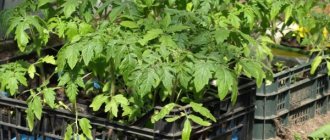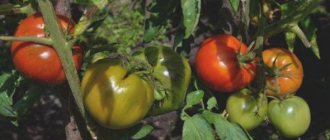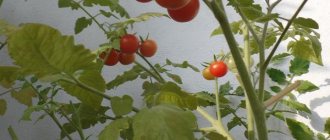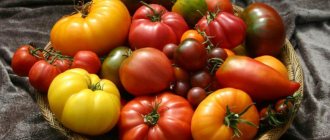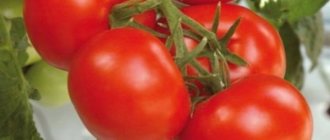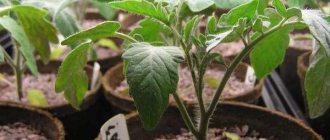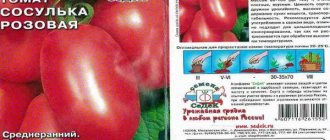Description of the variety
The Andreevsky Surprise tomato is a late-ripening and indeterminate hybrid; the plant produces its first full harvest no earlier than 3-4 months after the start of the growing season. The variety has a fairly developed tap root system. The roots develop quite quickly and, under favorable conditions, can reach a depth of about 2 m. The stem of the plant is erect, powerful and branched, herbaceous type, rich green in color. Quite large leaves are formed on the main branches; they are characterized by dissection into large lobes of 3–5 pieces.
This tomato blooms profusely. Small yellow or pale yellow flowers up to 2 cm in diameter are formed on the bush; they are collected in characteristic racemose inflorescences. The tomato is considered a facultative self-pollinator - this means that both male and female pollination organs ripen on one flower.
Distinctive features of the variety:
- powerful and large stem up to 2 m high;
- large fruits;
- the characteristic shape of the bush, consisting of 1-2 main stems;
- the plant has no restrictions on the growth of the bush;
- The fruits ripen well both in open ground and in greenhouses.
How to grow tomatoes
Proper cultivation of Andreevsky Surprise tomatoes consists of timely moistening, loosening the soil and periodically weeding the beds from weeds. Although the crop has good disease resistance, gardeners still treat the soil with a weak solution of potassium permanganate.
Landing
If flower clusters begin to appear on the seedlings, it means that it is time to transplant the plants into open ground or into a greenhouse no later than two weeks later.
Violation of these deadlines will lead to a slowdown in crop growth, which will result in a subsequent reduction in yield. If it is not possible to transplant the tomatoes during this period, the flower cluster that appears is pinched off. So the planting dates are postponed for another week. Tomatoes planted on time will produce their first harvest within two months after transplanting to a permanent location.
Since the plants are tall, the height of the greenhouse must correspond to the height of the tomatoes (at least 2 m). The soil is warmed up well before planting tomatoes. Manure is spread evenly on it, which is covered with 15 cm of soil. A small layer of wood ash is placed between the manure and the soil.
Tomatoes are planted in open ground or in a greenhouse according to the following rules:
- leave 60 cm between plants, and 40 between rows;
- If possible, tomatoes are transplanted in cloudy weather, in the late afternoon;
- install a trellis or pegs in advance so that tall stems are more stable and do not break from strong winds.
Care
The Andreevsky Surprise variety is cared for in the standard way, like all tomatoes. To ripen the fruits, tomatoes are regularly moistened and fertilized.
Plant care:
- Water the tomatoes at the root (10 liters per bush once a week).
- Feed the crop every 3 weeks. Mineral fertilizers are alternated with organic ones, and for faster fruit ripening, potash fertilizers are applied.
- The soil around the bushes is loosened and weeds are removed at the same time.
Since the Andreevsky Surprise tomato variety is indeterminate, the bushes must be formed correctly. All stepsons are removed from the plant, and then it is brought into 1-2 stems.
Features of cultivation and possible difficulties
Both in open ground and in a greenhouse, tomatoes are tied to a trellis, but not too tightly. Otherwise, the plant will die. If the crop grows in a greenhouse, it must be ventilated by opening two opposite windows or doors.
Diseases and pests
Although the Andreevsky Surprise tomato variety has strong immunity, under unfavorable conditions or improper care there is a risk of plant disease. Therefore, prevention is needed.
Mosaic is a viral disease that manifests itself as yellow spots on the leaves and their subsequent deformation. For sowing tomatoes, whenever possible, use seeds that are 3-4 years old. Before planting, the grains are disinfected for 20-30 minutes in a 1% solution of potassium permanganate. Every 10 days, seedlings are treated with skim milk (1 liter of milk and 1 teaspoon of urea are dissolved in 10 liters of water). Sick plants are removed.
Late blight is a fungal disease. It covers the leaves with brown spots, which gradually spread to the fruits. To prevent and treat the disease, plants are sprayed with iodine solution (1 teaspoon per 10 liters of water) or calcium nitrate solution (1 tablespoon per 10 liters of water). The drug "Profit Gold" is also used.
Fruit characteristics and yield
The yield of the hybrid is quite high; subject to optimal growing conditions, up to 8 kg of tomatoes can be harvested from 1 m² of plantings. The plant is late-ripening, so the technical maturity of the fruit occurs no earlier than 125–130 days after the appearance of the first shoots.
Did you know? After entering Europe,
the tomato was for a long time considered an ornamental and even poisonous species, since in temperate climates, plant growers were unable to obtain fruit ovaries for a long time. The main distinctive characteristics of the Andreevsky Surprise tomato fruit:
- the average weight of one tomato is in the range of 300–600 g, the maximum can reach up to 800 g;
- the shape of the tomatoes is round, they are slightly flattened in a horizontal position, and also have vertical ribs starting at the tail and ending at the bottom;
- in the technical ripeness phase, the fruits have a rich pink color, turning into crimson tones;
- the pulp has a delicate tomato aroma and a moderate sweetish taste.
Advantages and disadvantages of the variety
- The main advantages of the hybrid over related varieties of tomatoes:
- can successfully withstand lack of lighting;
- bushes are resistant to late blight;
- high yield and large fruit size;
- an increased percentage of sugars in the pulp, which gives it a special delicate taste;
- The harvest has excellent taste characteristics.
- The main disadvantages of St. Andrew's surprise:
- long growing season, fruits ripen only at the end of the season;
- the excessively large size of the fruit does not allow them to be used entirely for preservation;
- ripe tomatoes are prone to cracking;
- the bushes are quite tall, so they require mandatory garter;
- plants need weekly pinching.
Growing conditions
To successfully cultivate St. Andrew's surprise, plants must be provided with standard conditions and microclimate. In addition to optimal lighting and timely fertilization, the tomato also needs to choose the right place. To do this, one should evaluate predecessors, as well as identify the compatibility of neighbors with culture.
Lighting
Tomatoes are light-loving and heat-loving representatives of the flora: seedlings can be successfully formed with about 8 hours of daylight, but plants require at least 14 hours for normal growth and development. The light should be bright and intense throughout the day, this makes it possible to accelerate the growth of green mass and shorten the growing season.
Find out more about other varieties of indeterminate tomatoes:
Temperature and humidity
Tomatoes are also picky about temperature. Seeds begin to germinate at +14...+16°C, however, the most favorable period of growth and development for tomatoes occurs only in the range of +20...+25°C. At temperatures above +35°C and below +12°C, a sharp inhibition of the activity of tissues and cells is observed, and with prolonged exposure such conditions can cause the death of bushes.
Tomatoes need moderate humidity. Although the plant comes from the hot subequatorial and tropical zones of South America, for its growth the indicator must be in the range of 45–60%, while the desired soil moisture is about 65–75%. Otherwise, favorable conditions are created in the beds for fungal infections. In addition, in order to protect the plantings from fungi, the humidity levels in the beds must be stable and with minimal fluctuations.
Fertilizer
Cultivation of tomatoes on the site involves the selection of a huge amount of various nutrients and minerals from the soil, so the beds require mandatory fertilizer.
During the entire growing season, tomatoes need at least 3 feedings, but it is better to do them every 2-3 weeks, until the green-ripening phase of the fruit. For this purpose, use any mineral fertilizers based on phosphorus and potassium. They are applied both in liquid and dry form, immediately before watering the soil. You can replace chemical fertilizers with complex organic fertilizer; for this, use a solution of chicken manure (1:15) with a flow rate of 5–10 l/m².
We also advise you to find out what to spray tomatoes for ovary.
Soil and predecessors
Tomatoes require well-fertilized and moderately dense substrates; sandy or loamy soils with a high agricultural background (well-prepared soil) and a pH within 5-6 units are best suited for this. If the site has black soil or clay soils, it is recommended to lighten them with river sand. Tomatoes do not like excessive amounts of organic matter in the substrate, so before planting, the territory of future beds is fertilized exclusively with mineral substances.
Often, the crop bears fruit on almost any soil, but it is necessary to pay special attention to the plant’s predecessors.
Tomatoes grow best after:
- pumpkins;
- zucchini;
- squash;
- cucumbers;
- turnips;
- green onions;
- beets;
- legume herbs.
You should not grow the crop after other varieties of tomatoes, potatoes and other nightshades, earlier than 3-4 years. Otherwise, the soil becomes a potential carrier of various infections and pest larvae. It is also worth paying attention to the proximity to other crops.
The tomato withstands well in proximity to:
- corn;
- pepper;
- onions;
- garlic;
- radish;
- celery;
- parsley;
- watermelon;
- melons;
- asparagus;
- beans.
Neighborhood with:
- other varieties of tomatoes;
- peas;
- potatoes;
- cabbage;
- cucumbers;
- grapes;
- turnip.
Important! Before planting tomatoes, the plantings should be fertilized with green manure. To do this, in the fall the area is sown with leguminous grasses (alfalfa, sainfoin, clover, etc.), which are mowed and plowed into the soil 2 weeks before planting.
Preparing and planting seeds
To achieve not only high yields from tomatoes, but also excellent taste, you need not only special preparation, but also further compliance with the optimal microclimate for young shoots. Without this, crops will suffer from low immunity, which almost always threatens their death.
Preliminary seed preparation
Seed preparation begins with their sterilization. This measure is mandatory, since only through sterilization can pathogens of various fungal infections be eliminated from the surface of seeds. To do this, the seed material is soaked in special bactericidal solutions; most often, 2% potassium permanganate or 70% alcohol solution is used for these purposes. In the first case, the seeds are soaked for 20 minutes, when using alcohol - no more than 10 minutes.
To improve the quality of seedlings, immediately before sowing, the seeds must be soaked in growth stimulants for 6–8 hours. Most often, solutions of “Sodium Humate”, “Kornevin” or “Zircon” are used for this. You can replace chemicals with aloe juice. To do this, it is mixed with clean water at room temperature (1:1), while soaking in an organic solution is extended to 24 hours.
Sowing seedlings
Sowing seeds is usually carried out in small garden trays or plastic boxes with a depth of at least 10 cm. For this, use any specialized garden substrate for seedlings. It can be replaced with a mixture of equal parts of turf soil, peat and sand.
It will be useful for you to learn about diseases of tomato seedlings.
Sow seeds in common rows or individual holes.
- With the row method, rows are created over the entire surface of the container with a row spacing of 3-4 cm. Sowing is carried out so that in the future there is a free space of at least 1-2 cm between the seeds.
- With the hole method, holes are made in the soil at a distance of 3-4 cm, 2-3 seeds are placed in each of them, of which over time only one sprout is left.
Regardless of the type of sowing, the seed depth should be within 1-2 cm.
Growing seedlings
The seeded containers are well moistened and then covered with a dome made of transparent polyethylene or glass. After this, they are transferred to a well-lit place, with a temperature of about +25°C. A southern or southwestern window sill is best suited for this, as the most intense lighting is observed here. After a week, the first shoots will appear, after which the dome can be removed; At this time, the plantings are thinned out as necessary, leaving a space of 3-4 cm between each sprout.
After removing the dome, tomatoes are grown at a temperature of +18...+20°C during the day and about +15°C at night. Before transplanting to a permanent location, the plants are provided with 10–15 hours of daylight; for this, the flowerpots should be illuminated with a garden or table lamp. The first week after removing the protective dome, the seedlings are watered once a week; in the phase of 2-3 leaves, watering is carried out every 4 days. Water is added to the pots in small portions, while sudden changes in soil humidity, which are always fraught with oppression for plants, are prohibited.
Did you know? The leading country in growing tomatoes is China. Every year, Chinese farmers manage to produce more than 50 million tons of fruit, which is a third of the world production of this vegetable.
Landing at a permanent place
Approximately 40–50 days after the first shoots appear, tomatoes can be transplanted into open soil. By this point, the plants should have formed 6–8 leaves, and the weather should have developed a stable thaw with an average daily minimum of about +15°C. Most often this time occurs no earlier than mid-May.
Seedlings are planted in rows or pits, to a depth of 25–30 cm. The traditional planting pattern is 60×60 cm, but when planting in rows, you can adhere to the 70×40 cm pattern. Thus, about 6–8 tomatoes should be placed per 1 m² of plantings .
How to grow seedlings
| Stage 1. Purchase of high-quality planting material Step 1. Calculate the approximate number of seeds needed for planting. Leave a small reserve as some will not sprout. Step 2. Purchase seeds from the store. You should not buy them from street vendors and in stalls in markets, where the quality leaves much to be desired | |
| Stage 2. Seed disinfection Step 1. Prepare a solution of potassium permanganate, it should be moderately saturated, as in the example in the photo. Mix the liquid thoroughly until all the crystals dissolve. Step 2. Place the seeds in gauze or a bandage so that you don’t have to fish them out individually later. Dip into the solution and leave for 15 minutes. Step 3. Remove the seeds and immediately rinse with warm, clean water. | |
| Stage 3. Treatment with a growth stimulator Step 1. Purchase any growth stimulator from a gardening store. Please read the instructions for use carefully. Step 2. Prepare the solution, follow the proportions prescribed by the manufacturer. Mix the liquid well. Step 3. Soak the seeds for the required time, then remove and dry a little | |
| Stage 4. Sowing seeds Step 1. Prepare the soil for seedlings; it is best to use the ready-made version, since it does not need to be disinfected. Also prepare suitable sized containers. Step 2. Fill the containers with soil so that you can then add another 1 cm. Distribute the seeds evenly over the surface, cover with soil and water. Step 3. Place in a warm place, check the soil moisture, add more if necessary. When seedlings appear, move them to a windowsill or other bright place. | |
| Stage 5. Picking Step 1. When the plant has 2 true leaves, carefully dig it up with a lump of soil and plant it in a small glass. Water well. Step 2. 2-3 weeks after the first picking, transplant the plants into containers with a volume of about 1 liter. Water | |
| Stage 6. Growing seedlings Step 1: Keep the plants on a windowsill or other warm, bright place. Spray the leaves with water from a spray bottle twice a day to maintain optimal humidity. Step 2. Start hardening 2 weeks before transplanting. On warm days, take the seedlings outside or keep them near an open window. |
Growing and care
To achieve good quality of future tomatoes, the plantings need to be given attention even after planting in open soil. Until the fruits ripen, tomato bushes require regular fertilizing and soil care. This helps create a special microclimate in the beds, with the help of which the fruits will be not only large, but also tasty.
Stepsoning
Since the Andreevsky Surprise variety is characterized by active growth of shoots throughout the growing season, the plants definitely need pinching and shaping. Pruning of bushes is carried out regularly; only in this case can one avoid excessive growth of ineffective parts. The first time the procedure is carried out 2-3 weeks after planting the seedlings. Excess shoots are removed from each tomato, leaving no more than 2-3 main branches, however, in conditions of dense plantings, one shoot can be left on each bush.
Important! All cut areas must be treated with crushed charcoal, this will help protect the tomatoes from fungal attack.
Subsequently, throughout the growing season, all stepsons that form from the axils of the leaves are removed. This is done before they lengthen to 4 cm, otherwise the procedure may have a negative effect on the plants. As the bush grows, it is also necessary to cut off the lowest tier of leaves and leaves shading the fruits. In cold climates, this will help shorten the growing season to 2 weeks.
Fertilizer
As mentioned above, tomatoes are fertilized at least 3 times per season:
- 2 weeks after germination;
- 2-3 weeks after transplantation;
- during flowering.
Experienced plant growers advise feeding plantings every 15–20 days.
Most often used for this:
- superphosphate (15–20 g/m²);
- phosphorus flour (50 g/m²);
- potassium nitrate (15–20 g/m²).
The preparations are applied both in dry form and in the form of a solution; for this, about 10 liters of water are used per 1 m². The greatest effectiveness for plantings is obtained by alternating different types of preparations with organic fertilizer (chicken manure solution 1:15). Also, when fertilizing tomatoes, you should definitely remember that nitrogenous fertilizers are contraindicated for plants - they often activate the growth of green mass, which negatively affects productivity.
Did you know? Along with tomatoes, the Solanaceae family includes such well-known, but at the same time different crops as potatoes and tobacco.
Tying up
Bushes are tied up as early as possible, most often this procedure is carried out 2 weeks after planting the seedlings. The tomatoes are attached to a strong support; for this, individual wooden pegs or steel rods are used, which are installed at a distance of 10–15 cm from the plant trunk. Since St. Andrew's surprise has a fairly large trunk, the length of the support is chosen so that its above-ground part is at least 2 meters.
The bushes are tied to a support in the middle of the trunk or slightly higher; as the point of the garter grows, they are moved upward. The plants are fastened loosely, so that the garter does not hinder growth and does not cause damage to the trunk and fruit shoots. For the procedure, dense twine made of synthetic or natural materials is used.
Watering tomatoes after planting
Although St. Andrew's Surprise can withstand short droughts, the beds must be watered regularly. Moderate moisture has the most beneficial effect on the crop - for this, the planting must be moistened regularly, but in small portions.
In most cases, watering is carried out no more than once a week, and during the rainy season it is reduced to once every 2 weeks. For irrigation, use only clean and settled water, preheated to ambient temperature. Water the beds at the roots, avoiding wetting the foliage, otherwise an optimal environment is created for the development of dangerous infections.
Read more about how to properly water tomatoes in a greenhouse and in open ground.
Once a week, the day after watering, the plantings are weeded. This procedure is mandatory, as it helps saturate the soil with oxygen and also protect the beds from the appearance of weeds. The soil is weeded to a shallow depth - the first time one should be no more than 10 cm; during subsequent care, weeding is carried out to a depth of 5–7 cm.
Description and characteristics of the variety
Among tall and large-fruited vegetable crops, tomato stands out not only for its excellent taste, but also for its remarkable characteristics in the field of care and cultivation. The variety is suitable for producing marketable products in open ground both in areas with a warm climate and under cover in the northern regions.
A powerful indeterminate plant can reach 2.5-3 m in height; it produces large tomatoes with a fleshy structure. Among amateur gardeners they are called beef tomatoes. The first fruits surprise with their weight - 650 grams or more, and some record holders - up to 850 g.
Tomatoes are universally used and do not suffer from wateriness. They have the taste that all gardeners dream of - purely tomato, with a predominance of sweetness.
Prevention of diseases and pests
Prevention of the development of all kinds of diseases and dangerous pests of tomatoes on the site should begin in the fall. In October, before the first frost, the future area for tomatoes must be carefully dug to a depth of at least 25 cm (before sowing green manure). This will allow the soil to freeze well, which will destroy most dangerous insects. For the same purpose, it is necessary to collect all remains of other cultivated plants from the site and dispose of them.
Immediately before planting seedlings, its roots should be soaked in a variety of complex protection products. Often, Aktara solutions are used for these purposes, which will best protect tomatoes from the development of aphids, May beetles and other insects.
Spraying with complex fungicidal preparations (Quadris, Ridomil) will help counter the development of infections among plantings. This procedure is carried out at least once a month, in dry weather, and only after the plants have fully rooted (2-3 weeks after planting). As an alternative, you can use spraying with 2% potassium permanganate or dusting plants with crushed wood ash.
Important! Treatment of plantings is stopped 2 weeks before harvesting, otherwise dangerous toxins and their derivatives will accumulate in the harvest.
Transplanting seedlings
The seedlings are moved to a permanent place only after the root system and stems have been strengthened. An indicator of the readiness of a crop for transplantation is the appearance of tassels and flowering. Tomatoes of the Andreevsky Surprise variety should be replanted no later than 2 weeks after these signs are detected.
The fruits will be ready for harvest within 2-2.5 months after planting, if it was done on time.
Delayed planting can seriously affect crop yield and growth. To delay the move to open ground or a greenhouse for a week, you can remove the brushes from the plant.
The soil for replanting is prepared in advance. It is loosened to fill it with oxygen. Moisten it no earlier than 2-3 days before transplantation. The soil should be treated with ash or a solution of potassium permanganate. This will destroy harmful bacteria.
Plants are placed at a distance of 60 cm from each other. For convenience, they are planted in rows, leaving 40-50 cm between them. The bushes should not shade each other, and the leaves and branches should be intertwined.
It is better to immediately prepare supports in the form of stakes and tie up the stems. The plant is tall, and it will be easier for it to cope with the weight of heavy fruits in this position. If you are going to plant this crop in a greenhouse, you need to take care of the space and place for its growth in advance.
Beginning vegetable growers or those who grow this variety for the first time should not forget about the rules for transplanting tomatoes:
- the soil is preheated:
- manure is poured into the holes and sprinkled with wood ash;
- the remaining soil is added on top (this combination will quickly regulate the temperature of the earth).
Harvest and storage
The first harvest of the Andreevsky Surprise variety is harvested in mid-September. The fruits ripen quite quickly, so they are removed from the plant every 2-3 days. Mass harvesting is carried out after the night temperature drops to +13°C, otherwise the tomatoes will lose their elasticity and keeping quality.
Tomatoes are harvested manually, using a sharp knife or pruning shears, which is used to separate the stalk from the main stem. If the harvested crop has not had time to ripen, it is placed in a warm and well-lit place, at a temperature of +20...+25°C. Depending on the stage of ripeness, the fruits are kept in such conditions for 5 to 10 days, after which they become completely edible.
The collected fruits are placed in cardboard or plastic boxes in several layers, and then moved to a cold and dry place with a temperature of 0 ... + 10 ° C; in such conditions, the crop can maintain its freshness for several weeks. A special vegetable storage facility is best suited for these purposes, but you can also store the harvest in the refrigerator.
Andreevsky Surprise is a high-yielding modern hybrid that can please the gardener not only with large fruits, but also with the excellent taste quality of the harvest. The variety is considered unpretentious, but for successful cultivation, tomatoes need timely and painstaking care. This includes preventive treatments against infections and pests, without which the efficiency of crop cultivation will be reduced significantly.
